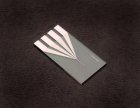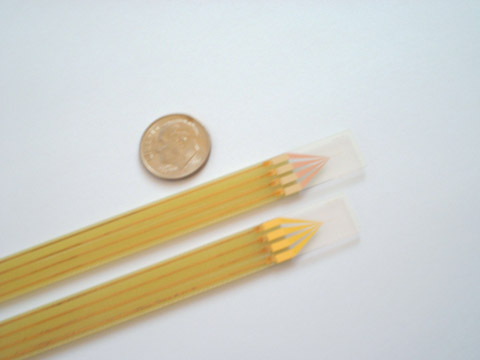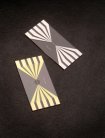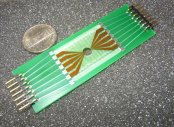|
INDEPENDENTLY
ADDRESSABLE MICROBAND ELECTRODESTM
(IAMEs) |
|
IME DEVICES |
Line and Space, Digit Length |
Designs |
Conductor |
|
IAIME 0505.3 SERIES |
5 microns, 3 mm long |
10 bands |
Au, Pt, ITO |
|
IAME 2004.3 SERIES |
20 microns, 3 mm long |
4 bands |
Au, Pt, ITO |
|
IAME 1504.3 SERIES |
15 microns, 3 mm long |
4 bands |
Au, Pt, ITO |
|
IAME 1004.3 SERIES |
10 microns, 3 mm long |
4 bands |
Au, Pt, ITO |
|
IAME 0504.3 SERIES |
5 microns, 3 mm long |
4 bands |
Au, Pt, ITO |
|
|||||||||
|
Ø Chip Substrate: |
Schott D263 Borosilicate Glass |
||||||||
|
Dielectric Constant, Epsilon(r) at 1 MHz |
6.7 |
||||||||
|
Dielectric Loss Angle, tan delta, at 1 MHz |
61 x 10-4 |
||||||||
|
Electrical Resistivity (50 Hz) (250 C) |
1.6 x 108 ohm cm |
||||||||
|
Coefficient of Linear Thermal Expansion, * 20-300 Deg C |
7.2 x 10^-6 K^-1 |
||||||||
|
Refractive Index at 20 C, ne ( Lambda = 546.1 nm) |
1.5249 |
||||||||
|
Ø Metallization: |
100 Å Ti|W / 1000 Å Au or Pt and ITO = 10 Ohms/sq |
||||||||
|
Ø IAIME 0505.3 |
|||||||||
|
Digit length, d, (microns) |
2,995 |
||||||||
|
No.of digit pairs per sensor, N |
5 |
||||||||
|
Digit Width, a, (microns) |
05 |
||||||||
|
Interdigit Space, a, (microns) |
05 |
||||||||
|
Spatial Periodicity, lambda, (microns) |
20 |
||||||||
|
Zaretsky Meander Length, M, (cm) |
1.50 |
||||||||
|
Center Line or Serpentine Length (cm) |
2.70 |
||||||||
|
Ø IAME XX04.3 Series |
2004.3 |
1504.3 |
1004.3 |
0504.3 |
|||||
|
Digit length, d, (microns) |
2,980 |
2,985 |
2,990 |
2,995 |
|||||
|
Digit Width, a, (microns) |
20 |
15 |
10 |
05 |
|||||
|
Interdigit Space, a, (microns) |
20 |
15 |
10 |
05 |
|||||
|
Spatial Periodicity, lambda, (microns) |
80 |
60 |
50 |
20 |
|||||
|
Ø IME Chip Dimensions |
Un-packaged Die |
Packaged Die |
|||||||
|
(l x w x t) |
(l x w x t) |
||||||||
|
IAIME 0505.3 |
1.50 x 3.00 x 0.05 cm |
13.2 x 1.38 x 0.7 cm |
|||||||
|
IAME XX04.3 |
1.00 x 2.00 x 0.05 cm |
13.2 x 1.38 x 0.7 cm |
|||||||
|
Ø Packaging |
|||||||||
|
Electrode Body: |
PVC-Jacketed printed circuit board |
||||||||
|
Encapsulant: |
Epoxy header. Polyimide packaged chip. |
||||||||
|
Leadwires: |
Color coded, 28 AWG stranded copper, shielded, and PVC jacketed |
||||||||
Back to Index |
|||||||||





